15 min to read
Are you searching for a way to grab your audiences attention and stand out from your competitors? Look no further, than hologram fans! These cutting edge marketing devices are rapidly becoming a must have in the advertising industry. Holograms offer possibilities for captivating customers through visually dynamic and interactive experiences. With life imagery and seamless integration of augmented reality (AR) and virtual reality (VR) hologram fan technology continues to push boundaries and revolutionize the world of advertising. In this blog post we will delve into how these extraordinary tools can help you expand your customer base and establish lasting connections, with them. Keep reading to discover the mesmerizing impact of hologram fans!
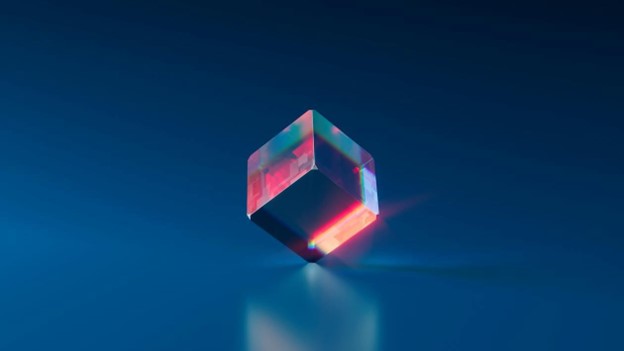
What are Hologram Fans and How They can be Used in Advertising
Hologram fans are interactive, 3D displays that use motion and light to create lifelike images. These devices consist of a spinning fan with built-in LED lights that project images onto the blades, creating a holographic effect. This technology allows for stunning visuals and animations to be displayed in mid-air, making it an eye-catching and attention-grabbing tool for advertising. With the ability to display larger-than-life holographic displays, businesses can easily showcase their products or services uniquely and memorably. From trade shows to storefront displays, hologram fans can be used in multiple settings to attract potential customers and leave a lasting impression. By incorporating these futuristic devices into their advertising strategies, businesses can create an immersive experience for their audience and stand out from the traditional forms of marketing.
Exploring the Benefits of Hologram Fans in Marketing Strategies
Hologram fans bring advantages when it comes to marketing strategies. Above all they provide a experience, for potential customers. The 3D images and animations showcased by hologram fans are truly unique in the realm of advertising making them stand out in a market. This distinctive display method not grabs attention but also sparks curiosity. Wonder among viewers. Such factors can contribute to increased brand awareness and even the potential for social media sharing. Furthermore hologram fans offer opportunities, for customization and personalization. Businesses can tailor their displays to align with their brand image and message resulting in a focused and impactful marketing campaign. Moreover these devices are cost effective when compared to forms of advertising.
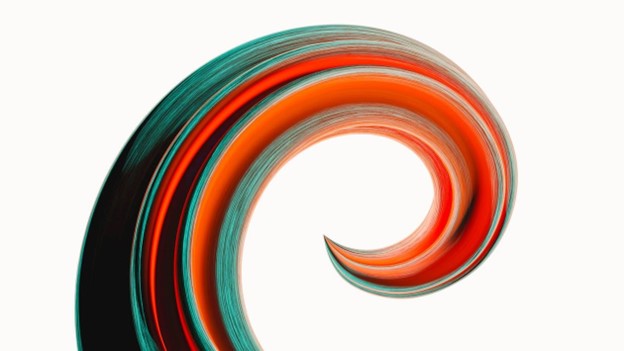
Clever Ways to Utilize Hologram Fans in Your Next Campaign
Incorporating hologram fans into your marketing campaign offers a multitude of possibilities. One interesting idea is to utilize them during product launches or reveal events. The captivating visuals and interactive features of hologram fans can transform a product launch into an occasion generating buzz and anticipation for the new offering. Another option is to incorporate hologram fans as part of events or interactive displays. For instance at trade shows businesses can use these fans to showcase their products in an attention grabbing manner and engage with customers. They are also effective, in storefront displays attracting foot traffic and creating lasting impressions on passersby. Moreover businesses can leverage hologram fans in marketing campaigns by crafting AR/VR experiences that incorporate this technology. Not does this create moments, for customers but it also enables data collection and provides valuable customer insights.
Advantages of Using Hologram Fans for Brand Awareness
One of the benefits of utilizing hologram fans for promoting brand visibility is their ability to attract attention and make a lasting impact, on customers. As traditional advertising methods become saturated businesses are constantly seeking inventive ways to set themselves apart from competitors. Hologram fans offer an captivating display that undoubtedly helps businesses stand out in a market. Additionally these fans bring about a sense of novelty and excitement, for viewers making them more inclined to engage with the brand and share their experiences on social media platforms. This not boosts brand recognition. Also expands the reach of marketing campaigns through word of mouth sharing.
How to Create Engaging Hologram Fan Ads that Stand Out
Crafting captivating hologram fan advertisements can seem like an endeavor. With the right approach it can yield remarkable results in captivating your audiences attention. The initial step involves comprehending your target demographic and tailoring your message accordingly. What will resonate with them? What type of content would they find engaging and relevant? Additionally consider integrating elements that enable viewers to engage with the hologram display, such, as touchscreens or motion sensors. This personalizes the experience. Immerses the audience further. Another valuable suggestion is to utilize visuals and animations that not only capture attention but also cast a positive light on your brand. This approach ensures that your advertisement stands out while also elevating your brands image in a manner.
Tips for Launching a Successful Hologram Fan Campaign
Launching a hologram fan campaign requires planning and execution. The first step is to have an objective, in mind. Whether its boosting brand recognition promoting a product or simply differentiating from competitors. After that businesses should. Choose the suitable hologram fan based on their specific requirements considering the various sizes and capabilities available in the market. It is also crucial to grasp the aspects of setting up and operating a hologram fan, including lighting, positioning and content creation. Once all these logistical aspects are sorted out it's time to unleash creativity when it comes to content. Businesses should utilize high quality images and animations that align with their brand identity while resonating with their target audience. Additionally incorporating elements like touchscreens or motion sensors can significantly enhance the viewing experience. Finally effective promotion and distribution of the hologram fan campaign play a role in ensuring its success.
Hologram fans have become indispensable for businesses seeking to captivate their audience and make an impact in a market. With displays and limitless customization options these devices offer numerous advantages for marketing strategies. Integrating hologram fans into your campaign can create an immersive experience, for potential customers while boosting brand awareness and potentially going viral.
By adopting the strategy hologram enthusiasts can enhance their advertising efforts. Make a lasting impact, on consumers.
Best Hologram campaigns we found so far
SmartV Hypervsn Display Wall at The Sphere
This is a large-scale holographic installation inside The Sphere arena in Las Vegas. It consists of a 9 x 15 meter display wall, made up of 420 individual SmartV Hypervsn displays, capable of creating 360° avatar captures. This setup provides a visually stunning experience that surpasses traditional 3D billboards and hologram-like TV displays.
This installation in Las Vegas is a prime example of creating buzz and engagement through digital channels. By leveraging social media platforms like TikTok, Instagram, and YouTube, a digital marketing campaign can showcase the awe-inspiring nature of the display, encouraging user-generated content and influencer collaborations. Additionally, targeted online advertising can attract visitors to the arena, while virtual reality experiences can replicate the immersive experience for those unable to visit in person.

Proto and RTFKT x Nike, Takashi Murakami Collab
Proto and RTFKT x Nike, Takashi Murakami Collaboration: This project involved a partnership between Proto Inc., RTFKT (a virtual fashion platform), and Nike, featuring sneakers designed by artist Takashi Murakami. The launch included a realistic holographic avatar interacting with guests in Tokyo, showcasing the integration of holographic technology in retail and fashion.
The collaboration between Proto, RTFKT, and Nike for a holographic sneaker launch capitalizes on the intersection of fashion, technology, and art. A digital marketing approach here could involve a multi-channel campaign across social media, fashion blogs, and e-commerce platforms. Exclusive online events or virtual showrooms can enhance customer engagement, while data analytics can be utilized to tailor the campaign to the preferences of the target audience.

Hologram Zoo in Brisbane, Australia
This unique attraction features a zoo composed entirely of life-size holograms of animals. Spanning 1,500 square feet with two 20-meter tunnels equipped with screens, it presents more than 50 holographic animals, offering an innovative and interactive experience for visitors.
Promoting a holographic zoo involves creating a sense of wonder and education. Digital marketing efforts could include interactive educational content on websites and social media, virtual tours, and partnerships with wildlife conservation organizations. Email marketing campaigns can keep subscribers updated on new exhibits and events, while SEO strategies can increase online visibility to tourists and local visitors.

MAGIC AI Fitness Mirror
This product is a hybrid of digital signage, holograms, AR, and AI. It’s a mirror-screen equipped with a motion-tracking camera and a digital personal trainer. This prototype offers a new level of immersion for home fitness, allowing users to interact with a digital coach.
This fitness-focused holographic product blends technology with health and wellness. Digital marketing strategies can involve content marketing that emphasizes the benefits of a home fitness solution, leveraging platforms like health blogs, fitness influencers, and wellness apps. Online communities and forums can be used for customer engagement and feedback, essential for a product still in prototype mode.
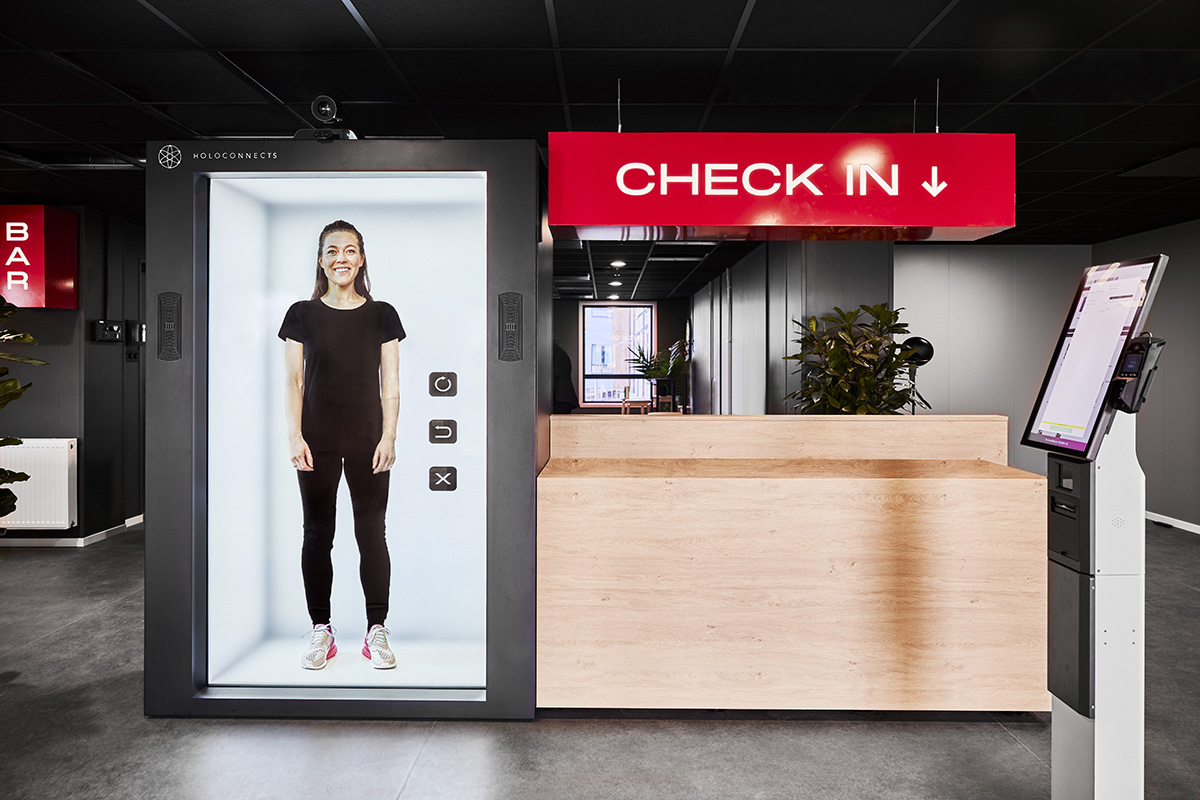
Hologram Check-in at Aiden by Best Western:
This example from the hospitality industry involves 30 boutique Aiden by Best Western hotels in Scandinavia using holographic technology developed by Holoconnects. It features a realistic hologram that assists with guest check-in, answers questions, and provides information, enhancing the guest experience and streamlining hotel operations.
The use of holographic technology in the hospitality industry offers a unique customer experience. Digital marketing here could involve virtual tours of the hotel on its website, showcasing the holographic check-in process. Email marketing can be used for personalized offers, while online reviews and testimonials can enhance the hotel’s reputation.
Costs and technology involved
The accessibility of hologram technology has greatly improved in years making it more accessible, to industries and businesses. In the past holographic technology was expensive and complex primarily used for high end applications such as large scale events or specialized sectors. However advancements in technology and increased demand have resulted in user friendly options.
Nowadays medium sized businesses can consider incorporating displays for marketing or operational purposes thanks to smaller and more cost effective models. While it may still be an investment for enterprises the decreasing cost and wider availability are making it a viable choice for a broader range of applications.
For businesses contemplating the adoption of this technology it is important to evaluate the costs versus the benefits. Hologram technology has the ability to create captivating experiences that can be a tool for marketing efforts, customer engagement, as well, as internal communications.
In terms of marketing hologram technology offers an opportunity to blend physical and digital strategies together resulting in memorable experiences that can enhance brand awareness and drive customer engagement.
To execute the hologram marketing examples discussed earlier, several key technologies are required:
SmartV Hypervsn Display Wall at The Sphere: This requires an advanced digital signage system comprising multiple Hypervsn displays, capable of creating high-resolution 3D visuals. The system also needs software for content management and synchronization across the displays.
The Hypervsn system, a common technology for creating holographic displays, can vary in price depending on the size and complexity of the installation. Individual units can cost several thousand dollars, and a large display wall like the one at The Sphere would likely involve a significant investment, potentially ranging into tens or even hundreds of thousands of dollars.
Proto and RTFKT x Nike, Takashi Murakami Collaboration: This involves holographic screens with realistic motion capture capabilities. The technology includes advanced cameras and software for capturing and rendering lifelike holographic images.
The cost of creating holographic displays for retail and fashion collaborations like this would depend on the scale and complexity of the holograms. These displays often involve sophisticated motion capture technology, which can be expensive. Custom projects for high-profile brands may cost from tens to hundreds of thousands of dollars.
Hologram Zoo in Brisbane, Australia: This setup requires large-scale digital signage technology and sophisticated holographic projection systems. It also involves interactive software to manage the display of various animal holograms.
A large-scale installation like a hologram zoo would require a substantial investment in both hardware (screens and projectors) and software. The cost would vary based on the number of holograms, their quality, and the interactive elements involved. Such a project could easily run into hundreds of thousands of dollars.
MAGIC AI Fitness Mirror: This product combines a mirror-screen with an integrated motion-tracking camera, augmented reality (AR) technology, and AI algorithms for interactive fitness coaching. Developing a product like the MAGIC AI Fitness Mirror, which integrates holograms, AR, and AI, would involve significant R&D costs in addition to the hardware components. The development and production of such innovative fitness technology could range from tens to hundreds of thousands of dollars.
Hologram Check-in at Aiden by Best Western: This application needs holographic projection technology, often in the form of a hologram box or a similar setup, along with interactive software for customer engagement and information dissemination. Holographic check-in systems for hotels, while simpler than some of the other examples, still require specialized hardware and software. The cost for each installation could range from a few thousand to tens of thousands of dollars, depending on the complexity and customization.
Each of these technologies involves a combination of hardware (like screens and cameras) and software (for content creation and management) to create immersive holographic experiences. Additionally, expertise in programming, digital marketing, and user experience design is crucial to ensure these technologies are effectively utilized. It's important to note that these are approximate ranges and the actual costs could vary based on specific requirements, customization, the scale of the project, and the vendor selected. Additionally, ongoing maintenance, content creation, and software updates can add to the total cost of ownership.

The near future of Hologram with AI
If you are a recurrent reader of our blog you know that we like to adventure ourselfs into predicting the future. HAHHA. Well. Sometimes we get it, sometimes we don't.
AI has the potential to make an impact, on the advancement of hologram technology. This is mainly achieved through improvements in machine learning, computer vision and data processing. By leveraging AI algorithms holographic displays can become more interactive, realistic and personalized. For example AI can analyze amounts of data in time to create more lifelike and responsive holographic images. It can also customize content according to viewers preferences or interactions.
The evidence supporting this viewpoint lies in the trends observed in both AI and holographic technology development. AI plays a role in enhancing image processing and rendering capabilities while also demonstrating its ability to understand and predict user behavior. Moreover the increasing integration of AI across tech driven industries reflects a movement towards enhanced experiences with the help of AI—holograms being an integral part of it all. The growing adoption of AI driven marketing strategies and interactive display solutions across industries serves as proof, for this trend.
A few years ago, i read an MIT article that I thought it was science fiction, but with Open AI and Google Gemini it totally possible.
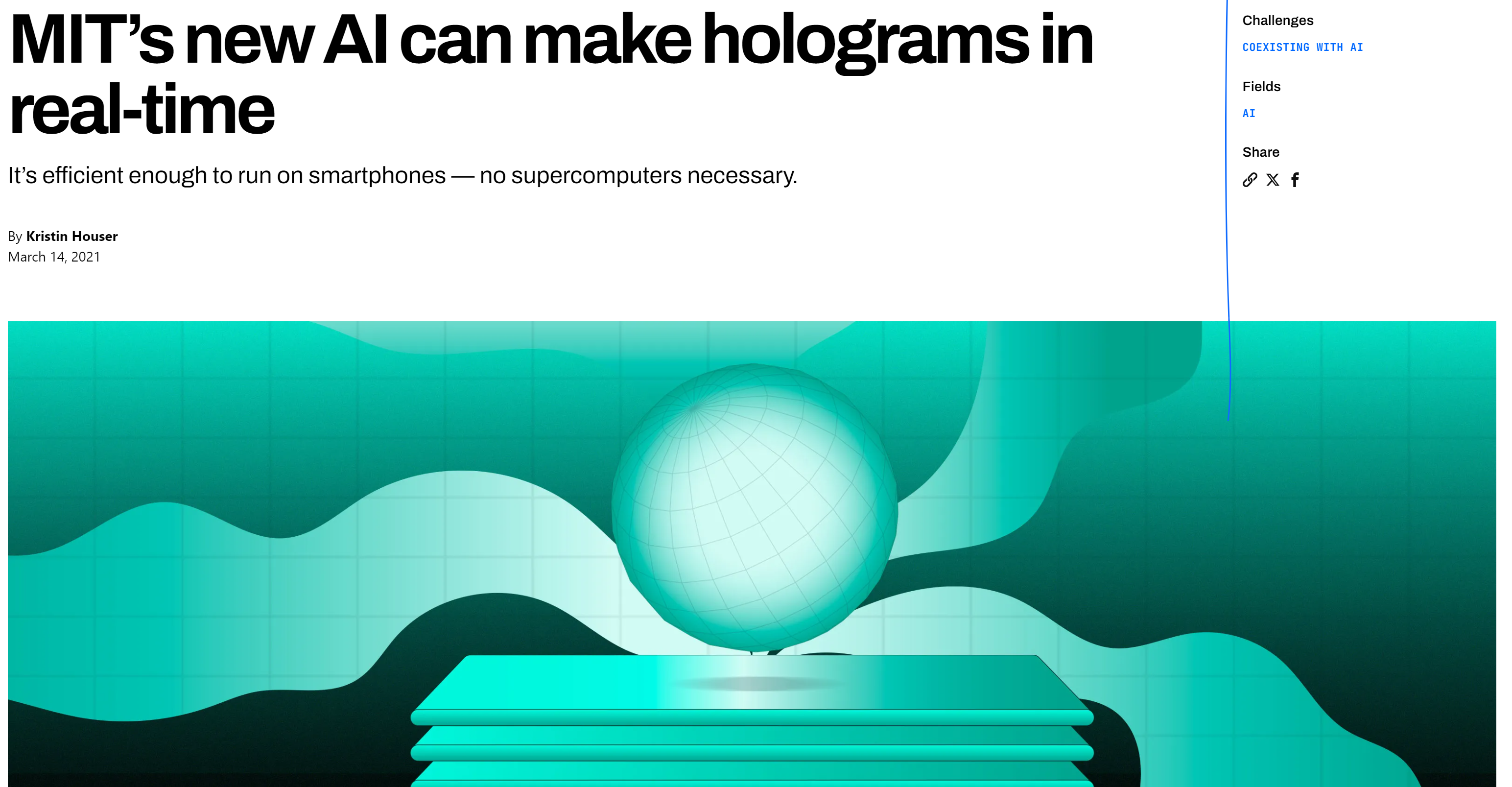
Freethink discusses a significant breakthrough at MIT in the field of holography, emphasizing the development of an AI-based technique for creating real-time holograms. This advancement is noteworthy for several reasons:
-
Efficiency and Accessibility: The new technique, dubbed "tensor holography," allows for the generation of holograms in real-time, efficiently enough to be performed on laptops or smartphones. This marks a substantial leap from previous methods that required immense processing power, typically necessitating supercomputers.
-
Technical Innovation: Traditional hologram creation involved using laser beams to produce static images, which were hard to replicate and couldn't be translated into video formats. The new AI approach overcomes these limitations by using a dataset of computer-generated images and corresponding holograms to train an AI. This AI can then generate photorealistic holograms from any 2D image in milliseconds, a process previously unthinkable in terms of speed and resource requirements.
-
Potential Impact on Various Fields: The development could revolutionize fields that benefit from holographic technology, such as virtual reality, 3D printing, and medical diagnostics. By making holography more accessible and versatile, it opens up new possibilities for interactive and immersive experiences in these domains.
-
The Role of AI: This advancement highlights the growing importance of AI in technological innovation. The ability of AI to process complex data and learn from it has proven to be a game-changer in making holography more practical and widely accessible.
In conclusion, MIT's development represents a significant stride in the field of holography, demonstrating how AI can be instrumental in overcoming previous technological limitations and opening new possibilities for practical applications of holographic technology. This advancement is not just a technical achievement but also a catalyst for innovation across various industries where holography can be applied.
FAQs . Frequently Asked Questions
What are hologram fans and how do they work in advertising?
Hologram fans, also known as 3D holographic fans, are innovative advertising tools that create the illusion of floating 3D visuals in the air through the rapid spinning of LED lights. These devices work by employing persistence of vision (POV) technology, where the LED blades rotate at high speeds, projecting images and videos that appear to float in mid-air. In advertising, hologram fans offer a visually captivating way to display products, messages, or animations, drawing attention in crowded retail spaces, exhibitions, and events. They serve as a novel medium to break through the clutter of traditional advertising by providing a futuristic and engaging consumer experience.
Can hologram fans be customized for different types of advertising campaigns?
Absolutely, hologram fans offer a high degree of customization, making them versatile for various advertising campaigns. Brands can tailor the 3D content to align with their campaign themes, objectives, and target audience preferences. Whether it's launching a new product, creating brand awareness, or promoting special events, the content displayed by hologram fans can be specifically designed to suit the purpose. This includes custom animations, brand logos, product visuals, and even short narrative videos. The flexibility of hologram fan technology allows for creative and innovative campaign executions that can adapt to different marketing strategies and goals.
What are the main benefits of using hologram fans in digital marketing strategies?
Incorporating hologram fans into digital marketing strategies offers several key benefits. Firstly, they provide a unique and immersive visual experience that can significantly enhance brand visibility and recall. The novelty factor alone can attract and retain customer attention more effectively than traditional 2D advertising. Secondly, these fans enable high-impact visual storytelling, allowing brands to convey their message in a more engaging and memorable way. Thirdly, they are versatile and can be used in various settings, from retail to events, adding value to the overall customer journey. Additionally, hologram fans can complement online and social media campaigns by creating shareable, buzzworthy content that bridges the gap between digital and physical marketing channels.
How can businesses incorporate hologram fans into their existing marketing campaigns?
Businesses can seamlessly integrate hologram fans into their existing marketing campaigns by using them as standout features in point-of-sale displays, exhibitions, trade shows, and promotional events. For instance, a retail store could use hologram fans to highlight new arrivals or best-selling products, creating a dynamic shopping environment. Similarly, during product launches or brand activations, these devices can provide an immersive experience that complements online and social media campaigns, encouraging user-generated content and social sharing. Strategically placing hologram fans in high-traffic areas can also drive foot traffic, enhancing overall campaign visibility and effectiveness.
What types of content work best with hologram fan technology?
Content that leverages the 3D and motion capabilities of hologram fans tends to be most effective. This includes dynamic animations, 3D product models, and visually striking graphics that make full use of the holographic effect to create depth and movement. Content that tells a story or showcases a product in an innovative way can captivate audiences, making the advertising message more impactful. Simpler, high-contrast visuals with vibrant colors also perform well, as they are more visible and attention-grabbing from a distance. Ideally, content should be designed specifically for the hologram fan format to maximize its potential.
Are hologram fans a cost-effective solution for small and medium-sized businesses?
For small and medium-sized businesses, hologram fans can be a cost-effective advertising solution when considering their potential return on investment. While the initial cost for the equipment and custom content creation may be higher than some traditional advertising methods, hologram fans offer a reusable and versatile platform. They can display different content over time, adapting to various campaigns without additional hardware costs. Their ability to attract attention and create memorable brand experiences can also translate into increased customer engagement and sales, potentially outweighing the initial investment. However, the cost-effectiveness will largely depend on how well they are integrated into a comprehensive marketing strategy and the competitive edge they provide in capturing customer interest.
How do hologram fans enhance customer engagement compared to traditional advertising methods?
Hologram fans enhance customer engagement by offering a novel and interactive visual experience that stands out from traditional advertising methods. Unlike static billboards or standard digital screens, hologram fans create a 3D illusion that can physically stop consumers in their tracks, prompting curiosity and interaction. This increased engagement is not just about the technology's novelty; it's also about its ability to convey messages in a more dynamic and immersive way. When consumers encounter something as futuristic and captivating as a hologram fan, they are more likely to remember the experience and, by extension, the brand or product being advertised. This level of engagement is invaluable in a crowded advertising landscape, where differentiation and memorability are key to success.
Can hologram fan content be interactive, and if so, how?
Yes, hologram fan content can be made interactive with the integration of sensors, augmented reality (AR), or interactive interfaces. For instance, motion sensors can trigger changes in the holographic display when a viewer approaches or moves around the device, creating a responsive and engaging experience. Additionally, combining hologram technology with AR apps on smartphones or tablets can allow users to interact with the holographic content in real-time, such as changing the displayed product or accessing more information. This interactivity not only enhances the viewer's experience but also provides businesses with opportunities to engage with their audience in a more meaningful and personalized way.
What are some successful examples of hologram fan campaigns?
Successful hologram fan campaigns often involve innovative uses of the technology to create buzz and enhance brand visibility. For example, high-end retailers have used hologram fans to create dynamic window displays featuring rotating 3D models of their products, attracting attention from passersby and driving foot traffic. Automotive brands have utilized hologram fans at auto shows to present floating car models and highlight features in an eye-catching manner. Similarly, entertainment companies have promoted movies or video games with holographic displays of characters or scenes, creating immersive experiences that generate excitement and social media buzz. These campaigns demonstrate the power of hologram fans to captivate audiences and create memorable brand interactions.
What is the future of advertising with hologram fans and AI technology?
The future of advertising with hologram fans and AI technology looks incredibly promising, with advancements likely to further enhance personalization, interactivity, and immersive experiences. AI can play a crucial role in optimizing content for hologram fans, using data analytics to tailor messages to specific audiences or even individual viewers. Additionally, AI-driven interactivity could allow hologram displays to react in real-time to audience emotions or behaviors, creating highly engaging and personalized experiences. As these technologies continue to evolve, we can expect hologram fans to become an integral part of omnichannel marketing strategies, offering new ways to bridge the digital and physical worlds and providing unprecedented opportunities for creative and impactful advertising.

About Bruno GavinoBruno Gavino is the CEO and partner of Codedesign, a digital marketing agency with a strong international presence. Based in Lisbon, Portugal, with offices in Boston, Singapore, and Manchester (UK) Codedesign has been recognized as one of the top interactive agencies and eCommerce agencies. Awarded Top B2B Company in Europe and Top B2C company in retail, Codedesign aims to foster personal relationships with clients and create a positive work environment for its team. He emphasizes the need for digital agencies to focus on data optimization and performance to meet the increasingly results-driven demands of clients. His experience in digital marketing, combined with a unique background that includes engineering and data, contributes to his effective and multifaceted leadership style. |

About CodedesignCodedesign is a digital marketing agency with a strong multicultural and international presence, offering expert services in digital marketing. Our digital agency in Lisbon, Boston, and Manchester enables us to provide market-ready strategies that suit a wide range of clients across the globe (both B2B and B2C). We specialize in creating impactful online experiences, focusing on making your digital presence strong and efficient. Our approach is straightforward and effective, ensuring that every client receives a personalized service that truly meets their needs. Our digital agency is committed to using the latest data and technology to help your business stand out. Whether you're looking to increase your online visibility, connect better with your audience, get more leads, or grow your online sales. For more information, read our Digital Strategy Blog or to start your journey with us, please feel free to contact us. |
CodeDesign is leading:
- Digital Agency
- Digital Marketing Agency
- Digital Ecommerce Agency
- Amazon Marketing Agency
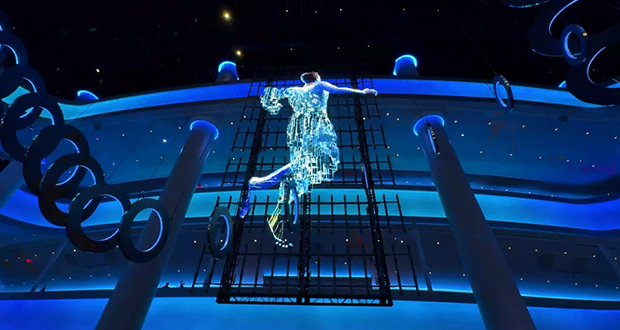

Add comment ×